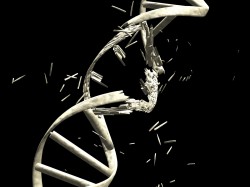Tags
DNA, genes, genetic engineering, GMOs, herbicides, Monsanto, pesticides, results, toxins, unexpected, unpredictable
 DNA is still largely a mystery to scientists. They know very little about this highly complex molecule found inside the nucleus of every cell. DNA, or deoxyribonucleic acid, is compared to the blueprint for the body’s cells. Scientists have determined that only about 1 to 3 percent of DNA is made up of genes, which carry the orders for how organisms are structured and function.
DNA is still largely a mystery to scientists. They know very little about this highly complex molecule found inside the nucleus of every cell. DNA, or deoxyribonucleic acid, is compared to the blueprint for the body’s cells. Scientists have determined that only about 1 to 3 percent of DNA is made up of genes, which carry the orders for how organisms are structured and function.
When biotech companies attempt to engineer the genes of various organisms, they meet with unexpected and unpredictable results. Let’s look at some examples found in the book Seeds of Deception by Jeffrey M. Smith:
- Scientists engineered tobacco to produce a particular acid. But the plant also created a toxic compound not normally found in tobacco.
- Monsanto engineered cotton to either withstand applications of their herbicide or produce its own pesticide. However, tens of thousands of acres “malfunctioned.” In Missouri, plants dropped their cotton bolls; others died on contact with the herbicide they were supposedly engineered to tolerate. In Texas, up to 50 percent of the cotton failed to provide the predicted level of insecticide and “numerous farmers had problems with germination, uneven growth, lower yield and other problems.”
- Scientists who genetically modified yeast to increase its fermentation were shocked to discover that it also increased levels of a naturally occurring toxin by 40 to 200 times.
There are so many unknown factors in the working of DNA and its gene sequence that scientists cannot possibly control the results of genetic manipulation. We cannot believe biotech company claims that genetic engineering is an exact and safe science.
